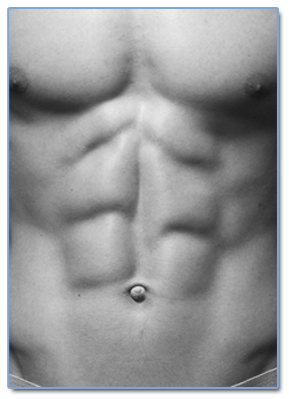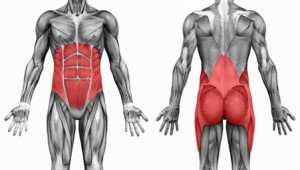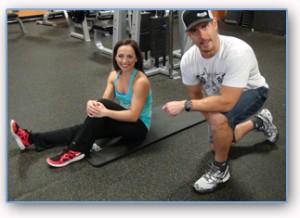

By Injury Specialist & Kinesiologist Rick Kaselj, MS
The sit-up or more specifically, the ‘crunch’ has been an exercise staple for decades. Proponents of the crunch touted it as the ideal exercise for building six-pack abdominals and ridding the stomach of excess fat. Since as far back as the 1940s fitness ‘gurus’ in gyms, on television and in magazines suggested that the crunch offered a fast track to a lean, well-defined mid-section.
And for nearly as long, the real fitness experts have been saying “No, no no….the crunch does none of those things and is in fact, a horrible exercise that increases the risk of injury—particularly the back.” Let’s take a look and see which viewpoint is correct.
 We’ll start by taking a look at the crunch movement to get a better perspective. There are a nearly endless variety of ways to perform the crunch but among all of them, the basic movements are essentially the same. The movement begins by lying face up on the floor with knees bent. Next, curl the shoulders towards the pelvis with the lower back remaining on the floor. The movement is repeated anywhere from 20 to a hundred times or more. The hands can be behind or beside the neck or crossed over the chest.
We’ll start by taking a look at the crunch movement to get a better perspective. There are a nearly endless variety of ways to perform the crunch but among all of them, the basic movements are essentially the same. The movement begins by lying face up on the floor with knees bent. Next, curl the shoulders towards the pelvis with the lower back remaining on the floor. The movement is repeated anywhere from 20 to a hundred times or more. The hands can be behind or beside the neck or crossed over the chest.
Crunches can be more difficult by: placing the feet up on a bench with the back on the floor; performing the movement on an exercise ball; performing the movement on a decline bench; twisting the torso during the up movement; or even by placing a weight plate, kettle bell or dumbbell on the chest to make the up movement more difficult.
But while in theory the crunch is perceived to be a simple, relatively safe exercise, this is not necessarily the reality.
The problem is that most people do not perform the movement properly, placing them at risk for injury. The risk and likelihood of injury increases exponentially as the crunch movement is made more complex or challenging by adding weights, exercise balls or other apparatuses.
You may be wondering how I’m qualified to answer that question and I don’t blame you for asking. For the past sixteen years I’ve been working with clients as an Injury Specialist and I’ve given over 315 live presentations to over 6065 healthcare and fitness professionals across Canada and the USA. My work has been featured in some of the media outlets below.

Sure credentials are great but real world experience with my own clients has shown me the specifics about why the crunch can be horrible for your back.
Let’s first look at the factors that keep the spine healthy and free of pain. First and foremost, a strong core is essential to a healthy back. Weak core muscles can increase the risk of lower back injury and pain. Strong core muscles reduce the risk for lower back pain by helping you to maintain correct posture and reduce strain on your spine. Poor posture can also result in back pain.

 This is a problem for two reasons. First, this creates an imbalance between weak and strong muscles with the most important muscles—the inner ones—being overlooked. And while the outer muscles may look good, they do nothing to protect the stability or integrity of the spinal column. Second, strong outer muscles covering weak core muscles provide a false sense of security, significantly increasing the risk of back injury.
This is a problem for two reasons. First, this creates an imbalance between weak and strong muscles with the most important muscles—the inner ones—being overlooked. And while the outer muscles may look good, they do nothing to protect the stability or integrity of the spinal column. Second, strong outer muscles covering weak core muscles provide a false sense of security, significantly increasing the risk of back injury.
Crunches also increase the risk of back injury by reinforcing bad habits that result in poor posture. Some people have a tendency to try and flatten their spine against the floor or the bench when performing crunches. However, the spine is curved for a reason—forcing it into an unnatural position increases the risk for injury.
Other bad crunch habits that can lead to poor posture include tucking the butt under or holding in the abs during the movement. All three of these common bad habits compromise the natural integrity of the spinal form.
Nerve damage is another potential consequence of too many crunches. The crunch movement puts an unhealthy strain on the back right at its weakest point, which coincidentally is the section that contains the most nerves. Damage to this weak area of the spine can result in serious, chronic pain that can last a lifetime and inhibit mobility and flexibility.
 Lastly, crunches repeatedly flex and extend the spine, which is comprised of a series of interconnected discs. Much like any piece of complicated machinery, the spinal discs are subject to wear and tear—in other words, they are only able to support a certain number of bending motions over the course of a lifetime.
Lastly, crunches repeatedly flex and extend the spine, which is comprised of a series of interconnected discs. Much like any piece of complicated machinery, the spinal discs are subject to wear and tear—in other words, they are only able to support a certain number of bending motions over the course of a lifetime.
Subjecting the spinal discs to the excessive wear and tear of crunches can reduce the ‘shelf life’ of spinal discs and result in nerve damage, a disc bulge or disc herniation, all of which are difficult to treat.
A review of the facts shows that indeed, crunches can be very bad for the back. While they do have some benefits, the risks of injury and back pain far outweighs any potential gains. If your goal is develop six-pack abdominals and strengthen your core, there are much better, more effective and safer options available.

If you’ve been crunching and doing sit-ups for years and have any degree of back pain don’t feel totally frustrated. I have teamed up with Critical Bench to publish a quick & easy 10-minute pre and post workout routine you can follow to reverse the damage.
Dealing with back pain in general even if it’s mild most often times involves endless cycles of appointments, investigations, stretching and strengthening.
After having hundreds of my clients go through this run-around, with minimal success, it has led to the creation of the BR3 Method which is based on one key concept: Reshaping your lower back from a painful lower back to a pain-free lumbar spine, which I’ll tell you more about on the next page.


However, if you’re ready to take control of your pain or avoid it altogether and what you’re currently doing isn’t helping, you’re in good hands.
I help athletes and and serious fitness enthusiasts get back to what they have a passion for instead of telling them to stop training and avoiding what hurts. Sound good?
If you’d like to escape a major blowout and fix your back in just minutes…so you can get back to your 100% intensity pain-free workouts without feeling bullied into appointments, medications or going under the knife, I have some amazing tips for you on the next page.